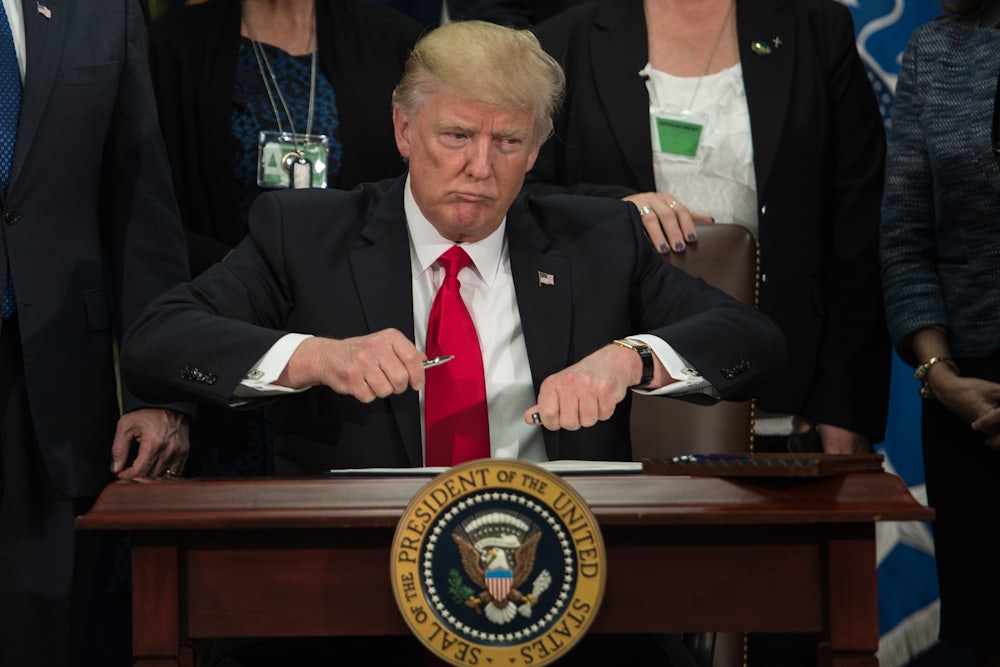The Environmental Protection Agency is thrilled with Donald Trump’s proposed budget for fiscal year 2018. According to an agency press release on Tuesday, the budget “provides $5.655 billion to help the agency protect human health and the environment.” It “aims to reduce redundancies and inefficiencies and prioritize EPA’s core statutory mission of providing Americans with clean air, land, and water,” and it allocates millions of dollars for clean air programs, Superfund and Brownfield site cleanups, and safe drinking water.
Given such rosy language, one would be forgiven for missing the fact that Trump’s budget would reduce the EPA’s funding by 31 percent—the highest percentage cut to any federal agency—and ax 3,200 employees. The Superfund program would get cut by 25 percent, the Brownfields program by 36 percent. And while the agency says the budget is “improving America’s air quality” and “ensuring clean and safe drinking water,” it ignores the dramatic cuts to programs that aim to do both things.
The EPA isn’t alone. Several other agencies with scientific and environmental missions would also be decimated by Trump’s budget, and they’re putting an equally positive spin on the proposed cuts—using conspicuously similar, euphemistic language.
Take the Department of Interior, which controls national parks and energy development on public lands. Trump proposed hacking its budget by 11 percent, crippling programs to restore abandoned coal mines, acquire more federal land, and financially assist National Heritage Areas. But in a statement, the agency applauded the proposal, saying it “allows Interior to carry out its core mission of responsible multiple-use of public lands.”
The Department of Agriculture’s funds would fall by 21 percent, the third-largest proposed cut by percentage, hacking crop insurance and rural development for farmers and eliminating initiatives like the Farm Safety Program. Sonny Perdue, the agency’s administrator, applauded the proposal, saying in a statement that he would fulfill “the core mission of USDA.”
The U.S. Geological Survey would be cut by 15 percent, which the department said represents “a continued commitment to the bureau’s core mission.” And the Department of Energy, which would be cut by 6 percent, said the budget would allow the agency to “reprioritize spending in order to carry out DOE’s core functions efficiently and effectively.”
The idea that massive cuts will allow these agencies and departments to return to their “core missions” or “core functions” is laughable—it’s not the only similarity in language between these press releases.
Four out of five of the releases applaud Trump’s “efficiency.” The USGS says Trump’s proposal is “increasing efficiency across the federal government.” The USDA said Trump was ensuring agencies “are efficiently delivering services.” The EPA said the budget would “reduce redundancies and inefficiencies.” And the DOE said the budget would help it run more “efficiently and effectively.” Two agencies also insisted the cuts would eliminate redundancies: to “eliminate duplication or redundancy,” in the USDA’s case, or “reduce redundancies and inefficiencies,” as the EPA put it.
Of course, “redundancies” and “efficiency” are just euphemisms. The point of the cuts is not to make these agencies more streamlined and cost-effective, but to force them to do less with less, curtailing their ability to enact and enforce regulations.
The stark similarities between the language in these press releases raises the question: Was their messaging directed by the White House? Anne-Berry Wade, a USGS press officer, said she “did not work in consultation with the White House” on their release, and that the phrase “core mission” is “fairly standard and often used by the USGS,” not something the DOI inserted. Wade did add, however, “Each agency’s press release has to be cleared by OMB and the DOI. This has been a standard practice for many many years, regardless of Administration.” That may be, but the USGS press release about President Barack Obama’s fiscal 2014 budget request, for instance, made no mention of “a continued commitment to the bureau’s core mission,” as this year’s does—perhaps because Obama recommended a 9 percent increase, not cuts.
The other agencies in question did not return my request for comment. But if their celebratory press releases are to be believed, perhaps their public relations officers are too busy celebrating the Trump administration’s proposal to return them to their core mission of efficiently accomplishing nothing at all.
